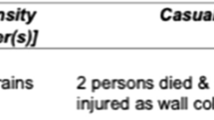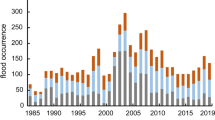Abstract
There is a need for comprehensive, standardised and georeferenced information on floods for political and economic decision-making. Relevant, accurate and up-to-date data is an important aspect for resource distribution, mitigation programmes, disaster monitoring and assessment. Despite this, there is a lack of spatial and thematic accurate global data for floods. In Europe, historic data on flood losses and casualties are neither comprehensive nor standardised, thus making long-term analyses at continental level difficult. In this article, we present a map and catalogue of the major flood events of the last 56 years in the European Union (EU), Bulgaria and Romania. This study is an effort to alleviate the lack of homogeneous and georeferenced information on flood disasters for large periods in Europe. The objectives of this paper are to identify and classify the major flood disasters of the last 56 years in the EU; to map the major flood disasters at pan-European scale with the support of a potential flood hazard map and ancillary GIS datasets; and to give a picture of the current situation for major floods in the EU on the basis of past events and current trends.
The Emergency Events Database (EM-DAT) of the Centre of Research on Epidemiology of Disasters in Brussels (CRED) and United States Office for Foreign Disaster Assistance (OFDA) and NATHAN of Munich Re are two of the main public global databases for natural disasters. Information from EM-DAT and NATHAN on flood disasters producing more than 70 casualties and/or more than 0.005% of EU GDP in damage has been assessed for the production of the map and catalogue of major flood disasters in Europe.






Similar content being viewed by others
Notes
EM-DAT: The OFDA/CRED International Disaster Database, Université Catholique de Louvain, Brussels, Belgium. See at http://www.em-dat.net
Available at: http://www.munichre.com
Available at: http://earth.esa.int/ew/floods
Available at: http://moland.jrc.it/publications/MajorFloods1950–2005.pdf
References
Austin B, Cheesman P, Maggs C (2000) United Kingdom floods. Guy Carpenter, Instrat, London, UK
Berz G (2000) Flood disasters: lessons from the past–worries for the future. P I Civil Eng-Mar En 142:3–8
Berz G, Kron W, Loster T, Rauch E, Schimetschek J, Schmieder J, Siebert A, Smolka A, Wirtz A (2001) World map of natural hazards–a global view of the distribution and intensity of significant exposures. Nat Hazards 23:443–465
Bronstert A (2003) Floods and climatic change: interactions and impacts. Risk Anal 23:545–557
CEC (2004) Flood risk management, Flood prevention, protection and mitigation, Commission of the European Communities, COM(2004)472 final Brussels 12.07.2004
CEC (2006) Proposal for a Directive on the assessment and management of floods, Commission of the European Communities, COM(2006)15 final, Brussels 18.01.2006
Christensen JH., Christensen OB (2003) Climate modelling: severe summertime flooding in Europe. Nature 421:805–806
Crichton D (1999) The risk triangle. In: Ingleton J (ed), Natural disaster management. Tudor Rose, London, pp 102–103
De Roo APJ, Wesseling CG, Van Deursen WPA (2000) Physically-based river basin modelling within a GIS: The LISFLOOD model. Hydrol Process 14:1981–1992
De Roo A, Gouweleeuw B, Thielen J, Bartholmes J, Bongioannini-Cerlini P, Todini E, Bates P, Horritt M, Hunter N, Beven K, Pappenberger F, Heise E, Rivin G, Hils M, Hollingsworth A, Holst B, Kwadijk J, Reggiani P, Van Dijk M, Sattler K, Sprokkereef E (2003) Development of a European flood forecasting system. Int J of River Basin Management 1:49–59
De Roo A, Barredo JI, Lavalle C (2005) Pan European Flood Risk Assessment. In: Proceedings of third international symposium on flood defence, Ministry of Transport, Public Works and Water Management, Nijmegen, The Netherlands, pp 25–27
De Roo A, Barredo JI, Lavalle C, Bodis K, Bonk R (2007) Potential flood hazard and risk mapping at pan-European scale. In: Peckham R, Jordan G (eds), Digital Terrain Modelling-Development and Applications in a Policy Support Environment. Springer (in press)
Dilley M, Chen RS, Deichmann U, Lerner-Lam AL, Arnold M, Agwe J, Buys P, Kjekstad O, Lyon B, Yetman G (2005) Natural disaster hotspots: a global risk analysis, Synthesis Report. Center for Hazards & Risk Research at Columbia University
FAO (2001) Asia FIVIMS for Disaster Preparedness, In: Report of the FAO Asia-Pacific Conference on Early Warning, Prevention, Preparedness and Management of Disasters in Food and Agriculture, Chiangmai, Thailand, Annex XIII, available at: http://www.fao.org/DOCREP/005/AC120E/AC120E00.HTM
Glaser R (2001) Klimageschichte Mitteleuropas. 1000 Jahre Wetter, Klima, Katastrophen, WBG, Darmstadt
Grünewald U (2006) Extreme hydro(meteoro-)logische Ereignisse im Elbegebiet. Österreichische Wasser-und Abfallwirtschaft, 58(3–4):27–34
Grünewald U, Kaltofen M, Schümberg S, Merz B, Kreibich H, Petrow T, Thieken A, Streitz W, Dombrowsky WR (2004) Flood risk reduction in Germany-lessons learned from the 2002 disaster in the Elbe Region, German Committee for Disaster Reduction, DKKV Publication 29 e
IPCC (2001) Climate change 2001: The scientific basis. IPCC Third Assessment Report, Working Group I, Intergovernmental Panel on Climate Change (IPCC), Cambridge University Press.
Jonkman SN (2005) Global perspectives on loss of human life caused by floods. Nat Hazards 34:151–175
Kron W (2002) Flood risk = hazard × exposure × vulnerability. In: Wu B, Wang ZY, Wang G, Huang GGH, Fang H, Huang J (eds) Flood defence. Science Press, New York
Kundzewicz ZW, Schellnhuber H-J (2004) Floods in the IPCC TAR perspective. Nat Hazards 31:111–128
Kundzewicz ZW, Ulbrich U, Brucher T, Graczyk D, KruGer A, Leckebusch GC, Menzel L, Pinskwar I, Radziejewski M, Szwed M (2005) Summer floods in Central Europe–climate change track? Nat Hazards 36:165–189
Kundzewicz ZW, Radziejewski M, Pinskwar I (2006) Precipitation extremes in the changing climate of Europe. Clim Res 31:51–58
Mitchell JK (2003) European river floods in a changing world. Risk Anal 23:567–574
Mudelsee M, Borngen M, Tetzlaff G, Grunewald U (2003) No upward trends in the occurrence of extreme floods in central Europe. Nature 425:166–169
Munich Re (1998) World map of natural hazards, Munich Re—Munich Reinsurance Company, Munich
Munich Re (1999) Topics 2000: natural catastrophes – the current position. Munich Re—Munich Reinsurance Company, Munich
Munich Re (2001) Topics – Rétrospective des catastrophes naturelles survenues en 2000, Munich Re—Munich Reinsurance Company, Munich
Munich Re (2005) Topics Geo-Annual review: natural catastrophes, Munich Re—Munich Reinsurance Company, Munich
OcCC (2003) Extreme events and climate change, Organe consultatif sur les changements climatiques, Bern
Peduzzi P, Herold H, Dao C (2005) Mapping disastrous natural hazards using global datasets. Nat Hazards 35:265–289
Perry CA (2000) Significant floods in the United States during the 20th Century – USGS measures a century of floods, U.S. Geological Survey, Fact Sheet 024–00, March 2000
Pielke RA Jr (1999) Nine fallacies of floods. Clim Change 42:413–438
Pielke RA Jr, Downton MW (2000) Precipitation and damaging floods: trends in the United States, 1932–1997. J Clim 13:3625–3637
UNDP (2004) Reducing disaster risk. A challenge for development, UNDP, bureau for crisis prevention and recovery, New York, available at: http://www.undp.org/bcpr/disred/rdr.htm
USGS (2005) Flood Definitions, U.S. Geological Survey, Kansas Water Science Center, available at: http://ks.water.usgs.gov/Kansas/waterwatch/flood/definition.html
WHO (2002) Floods: climate change and adaptation strategies for human health, World Health Organization–Regional office for Europe
Verelst, L (1999) Recommendations for Geo-referencing EM-DAT Data Base, Consultancy Report prepared for the Asia FIVIMS Project and the CRED, Rome
Acknowledgements
We would like to thank the anonymous referees for their helpful suggestions. The views expressed are purely those of the writer and may not in any circumstances be regarded as stating an official position of the European Commission.
Author information
Authors and Affiliations
Corresponding author
Rights and permissions
About this article
Cite this article
Barredo, J.I. Major flood disasters in Europe: 1950–2005. Nat Hazards 42, 125–148 (2007). https://doi.org/10.1007/s11069-006-9065-2
Received:
Accepted:
Published:
Issue Date:
DOI: https://doi.org/10.1007/s11069-006-9065-2




